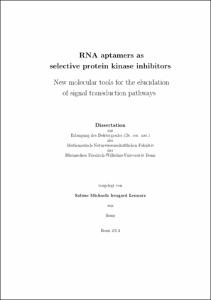RNA aptamers as selective protein kinase inhibitorsNew molecular tools for the elucidation of signal transduction pathways

RNA aptamers as selective protein kinase inhibitors
New molecular tools for the elucidation of signal transduction pathways

| dc.contributor.advisor | Mayer, Günter | |
| dc.contributor.author | Lennarz, Sabine Michaela Irmgard | |
| dc.date.accessioned | 2020-04-20T20:38:56Z | |
| dc.date.available | 2020-04-20T20:38:56Z | |
| dc.date.issued | 16.04.2015 | |
| dc.identifier.uri | https://hdl.handle.net/20.500.11811/6426 | |
| dc.description.abstract | Elucidating the precise function of individual protein kinases within complex signal transduction cascades represents one of the greatest challenges in molecular biology. Protein kinases are enzymes that catalyze the transfer of a phosphate group from ATP to proteins. In doing so, they promote alterations within the intricate network of intracellular signal transduction pathways. Deregulated signal transduction pathways caused by aberrant kinase activity drives a multitude of diseases.Because of this, protein kinases have become one of the most intensively pursued classes of drug targets. A comprehensive functional analysis of individual kinases involved in the biology of healthand disease is challenging and requires the development of specific inhibitors that can discriminate between highly homologous proteins. Most available protein kinase inhibitors are low molecular weight compounds that address the kinases active site and, thus, block kinase activity. These inhibitors have been proven useful for therapeutic applications but their use as research tools is often hampered by their lack of specificity. Herein, it was investigated if aptamers represent a promising new class of kinase inhibitors for chemical biology research that might overcome this limitation. Aptamers are single-stranded nucleic acids that adopt complex three-dimensional strucures. More importantly, aptamers are often able to modulate the function of their target protein in a highly specific manner. In this thesis, the potential of aptamers as selective protein kinase inhibitors was studied for two important kinases:G protein-coupled receptor kinase 2 (GRK2) and extracellular signal-regulated kinase 2 (Erk2). GRK2 is a key regulator of G protein-coupled transmembrane receptors and Erk2 is crucial for the regulation of proliferation and differentiation in cells. The ATP-competitive aptamer C13 and GRK2 were used to unravel the molecular determinants which contribute to the aptamer's highly specific interaction with its target. Crystallographic structures and biochemical assays revealed that the ATP-competitive aptamer forms extensive interactions both within and outside of the active site which contribute to its specificity and ability to block kinase activity. The two novel Erk2-binding aptamers C3 and C5 revealed that aptamers can bind distinct sites on one target and are able to employ ATP-competitive or allosteric modes of action in respect to kinase activity perturbation. This demonstrates their potential as domain-specific inhibitors. Aptamer C5 was shown to interfere with Erk2 activity in an ATP-competitive manner. Aptamer C3, on the other hand, recognized the MAP kinase (MAPK) insert region of Erk2. The intriguing ability of C3 to target MAPK insert specific functions was monitored in an activation cascade assay. In this assay, the aptamer was able to inhibit the activation of Erk2 by its upstream kinase Mek1 and to prevent subsequent substrate phosphorylation. Most importantly, this study implies that RNA aptamers can provide a new class of potent tools to manipulate intracellular kinase activity in neurons. Using aptamer C5, it was shown for first time that the application of an aptamer during whole-cell patch-clamp recordings offers a unique and generally applicable strategy to monitor spatio-temporal effects on individual protein kinases during neuronal functions. In summary, this thesis demonstrates the versatile potential of RNA aptamer as specific protein kinase inhibitors for chemical biology research and opens the avenue towards their application as tools to specifically interfere with kinase activity during neuronal signaling. | en |
| dc.language.iso | eng | |
| dc.rights | In Copyright | |
| dc.rights.uri | http://rightsstatements.org/vocab/InC/1.0/ | |
| dc.subject | Aptamer | |
| dc.subject | protein kinase | |
| dc.subject | MAP kinase | |
| dc.subject | Erk | |
| dc.subject | GRK2 | |
| dc.subject.ddc | 570 Biowissenschaften, Biologie | |
| dc.subject.ddc | 610 Medizin, Gesundheit | |
| dc.title | RNA aptamers as selective protein kinase inhibitors | |
| dc.title.alternative | New molecular tools for the elucidation of signal transduction pathways | |
| dc.type | Dissertation oder Habilitation | |
| dc.publisher.name | Universitäts- und Landesbibliothek Bonn | |
| dc.publisher.location | Bonn | |
| dc.rights.accessRights | openAccess | |
| dc.identifier.urn | https://nbn-resolving.org/urn:nbn:de:hbz:5n-39276 | |
| ulbbn.pubtype | Erstveröffentlichung | |
| ulbbnediss.affiliation.name | Rheinische Friedrich-Wilhelms-Universität Bonn | |
| ulbbnediss.affiliation.location | Bonn | |
| ulbbnediss.thesis.level | Dissertation | |
| ulbbnediss.dissID | 3927 | |
| ulbbnediss.date.accepted | 07.11.2014 | |
| ulbbnediss.institute | Mathematisch-Naturwissenschaftliche Fakultät : Fachgruppe Molekulare Biomedizin / Life & Medical Sciences-Institut (LIMES) | |
| ulbbnediss.fakultaet | Mathematisch-Naturwissenschaftliche Fakultät | |
| dc.contributor.coReferee | Hoch, Michael |
Files in this item
This item appears in the following Collection(s)
-
E-Dissertationen (4379)




